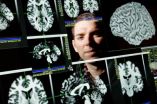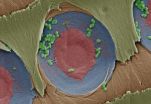(Press-News.org) CHAMPAIGN, Ill. — Researchers report that one change in the sequence of the BDNF gene causes some people to be more impaired by traumatic brain injury (TBI) than others with comparable wounds.
The study, described in the journal PLOS ONE, measured general intelligence in a group of 156 Vietnam War veterans who suffered penetrating head wounds during the war. All of the study subjects had damage to the prefrontal cortex, a brain region behind the forehead that is important to cognitive tasks such as planning, problem-solving, self-restraint and complex thought.
The researchers controlled for the size and location of subjects' brain injuries and other factors, such as intelligence prior to injury, which might have contributed to differences in cognitive function. (Prior to combat, the veterans had completed the Armed Forces Qualifications Test, which included measures of intelligence that provided a baseline for the new analysis.)
"We administered a large, cognitive battery of tests to investigate how they performed after their injury," said study leader Aron Barbey, a professor of speech and hearing science, of psychology and of neuroscience at the University of Illinois. "And we had a team of neurologists who helped characterize the nature and scope of the patients' brain injuries."
The researchers also collected blood for a genetic analysis, focusing on a gene known as BDNF (brain-derived neurotrophic factor).
The team found that a single polymorphism (a difference in one "letter" of the sequence) in the BDNF gene accounted for significant differences in intelligence among those with similar injuries and comparable intelligence before being injured.
"BDNF is a basic growth factor and it's related to neurogenesis, the production of new neurons," Barbey said. "What we found is that if people have a specific polymorphism in the BDNF gene, they recovered to a greater extent than those with a different variant of the gene."
The change in the gene alters the BDNF protein: The amino acid methionine (Met) is incorporated at a specific site in the protein instead of valine (Val). Since people inherit two versions of each gene, one from each parent, they have either Val/Val, Val/Met or Met/Met variants of the gene.
"The effects of this difference were large – very large," Barbey said. "If an individual had the Val/Val combination, then their performance on a battery of cognitive tests (conducted long after the injury occurred) was remarkably lower than that of individuals who had the Val/Met or Met/Met combination."
On average, those with the Val/Val polymorphism scored about eight IQ points lower on tests of general intelligence than those with the Val/Met or Met/Met variants, Barbey said. Those with the Val/Val variant also were significantly more impaired in "specific competencies for intelligence like verbal comprehension, perceptual organization, working memory and processing speed," he said.
To test these results, the researchers did the analysis over again "in a subset of individuals who had very similar (brain injuries) to the other group," Barbey said. "We found the same kind of effects, suggesting that lesion location isn't a factor influencing the difference between the groups."
The finding opens a new avenue of exploration for treatments to aid the process of recovery from TBI, Barbey said.
Barbey is an affiliate of the Beckman Institute at the U. of I.
INFORMATION:
The U.S. National Institute of Neurological Disorders and Stroke and the U.S. Army Medical Research and Material Command supported this work.
Editor's notes: To reach Aron Barbey (pronounced bar-BAY), call 217-333-2230; email barbey@illinois.edu.
The paper, "Preservation of General Intelligence Following Traumatic Brain Injury: Contributions of the Met66 Brain-Derived Neurotrophic Factor," is available online (after the embargo lifts) or from the U. of I. News Bureau.
One gene influences recovery from traumatic brain injury
2014-02-27
ELSE PRESS RELEASES FROM THIS DATE:
Caesarean babies are more likely to become overweight as adults
2014-02-27
Babies born by caesarean section are more likely to be overweight or obese as adults, according to a new analysis.
The odds of being overweight or obese are 26 per cent higher for adults born by caesarean section than those born by vaginal delivery, the study found (see footnote).
The finding, reported in the journal PLOS ONE, is based on combined data from 15 studies with over 38,000 participants.
The researchers, from Imperial College London, say there are good reasons why many women should have a C-section, but mothers choosing a caesarean should be aware that ...
Cows are smarter when raised in pairs
2014-02-27
Cows learn better when housed together, which may help them adjust faster to complex new feeding and milking technologies on the modern farm, a new University of British Columbia study finds.
The research, published today in PLOS ONE, shows dairy calves become better at learning when a "buddy system" is in place. The study also provides the first evidence that the standard practice of individually housing calves is associated with certain learning difficulties.
"Pairing calves seems to change the way these animals are able to process information," said Dan Weary, corresponding ...
Impact on mummy skull suggests murder
2014-02-27
Blunt force trauma to the skull of a mummy with signs of Chagas disease may support homicide as cause of death, which is similar to previously described South American mummies, according to a study published February 26, 2014 in PLOS ONE by Stephanie Panzer from Trauma Center Murau, Germany, and colleagues, a study that has been directed by the paleopathologist Andreas Nerlich from Munich University.
For over a hundred years, the unidentified mummy has been housed in the Bavarian State Archeological Collection in Germany. To better understand its origin and life history, ...
Tree branch filters water
2014-02-27
A small piece of freshly cut sapwood can filter out more than 99 percent of the bacteria E. coli from water, according to a paper published in PLOS ONE on February 26, 2014 by Michael Boutilier and Jongho Lee and colleagues from MIT.
Researchers were interested in studying low-cost and easy-to-make options for filtering dirty water, a major cause of human mortality in the developing world. The sapwood of pine trees contains xylem, a porous tissue that moves sap from a tree's roots to its top through a system of vessels and pores. To investigate sapwood's water-filtering ...
Waterbirds' hunt aided by specialized tail
2014-02-27
The convergent evolution of tail shapes in diving birds may be driven by foraging style, according to a paper published in PLOS ONE on February 26, 2014 by Ryan Felice and Patrick O'Connor from Ohio University.
Birds use their wings and specialized tail to maneuver through the air while flying. It turns out that the purpose of a bird's tail may have also aided in their diversification by allowing them to use a greater variety of foraging strategies. To better understand the relationship between bird tail shape and foraging strategy, researchers examined the tail skeletal ...
MIT researchers make a water filter from the sapwood in tree branches
2014-02-27
If you've run out of drinking water during a lakeside camping trip, there's a simple solution: Break off a branch from the nearest pine tree, peel away the bark, and slowly pour lake water through the stick. The improvised filter should trap any bacteria, producing fresh, uncontaminated water.
In fact, an MIT team has discovered that this low-tech filtration system can produce up to four liters of drinking water a day — enough to quench the thirst of a typical person.
In a paper published this week in the journal PLoS ONE, the researchers demonstrate that a small ...
Study finds social-media messages grow terser during major events
2014-02-27
In the last year or two, you may have had some moments — during elections, sporting events, or weather incidents — when you found yourself sending out a flurry of messages on social media sites such as Twitter.
You are not alone, of course: Such events generate a huge volume of social-media activity. Now a new study published by researchers in MIT's Senseable City Lab shows that social-media messages grow shorter as the volume of activity rises at these particular times.
"This helps us better understand what is going on — the way we respond to things becomes faster ...
Humans have a poor memory for sound
2014-02-27
Remember that sound bite you heard on the radio this morning? The grocery items your spouse asked you to pick up? Chances are, you won't.
Researchers at the University of Iowa have found that when it comes to memory, we don't remember things we hear nearly as well as things we see or touch.
"As it turns out, there is merit to the Chinese proverb 'I hear, and I forget; I see, and I remember," says lead author of the study and UI graduate student, James Bigelow.
"We tend to think that the parts of our brain wired for memory are integrated. But our findings indicate ...
DNA test better than standard screens in identifying fetal chromosome abnormalities
2014-02-27
BOSTON (Feb. 27) – A study in this week's New England Journal of Medicine potentially has significant implications for prenatal testing for major fetal chromosome abnormalities. The study found that in a head-to-head comparison of noninvasive prenatal testing using cell free DNA (cfDNA) to standard screening methods, cfDNA testing (verifi® prenatal test, Illumina, Inc.) significantly reduced the rate of false positive results and had significantly higher positive predictive values for the detection of fetal trisomies 21 and 18.
A team of scientists, led by Diana W. Bianchi, ...
More evidence that vision test on sidelines may help diagnose concussion
2014-02-26
PHILADELPHIA – A simple vision test performed on the sidelines may help determine whether athletes have suffered a concussion, according to a study released today that will be presented at the American Academy of Neurology's 66th Annual Meeting in Philadelphia, April 26 to May 3, 2014.
The study provides more evidence that the King-Devick test, a one-minute test where athletes read single-digit numbers on index cards, can be used in addition to other tests to increase the accuracy in diagnosing concussion.
For the study, 217 members of the University of Florida men's ...




